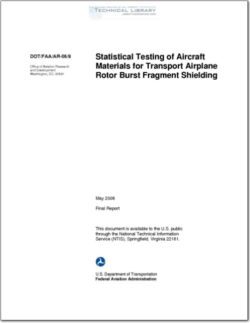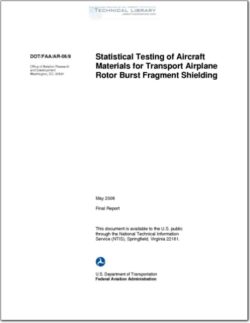DOT-FAA-AR-06-9

- Version
- 220 Downloads
- 7.36 MB File Size
- 1 File Count
- March 23, 2016 Create Date
- March 23, 2016 Last Updated
Statistical Testing of Aircraft Materials for Transport Airplane Rotor Burst Fragment Shielding

Fuselage fragment barrier systems are being examined and developed for commercial airplanes
to provide protection from an engine rotor burst failure. Part of this development was to
understand how the existing aircraft materials behave under ballistic impact, and then to model
those results to aid the aircraft industry in designing these barriers, and the evaluation of existing
aircraft structures for fragments from rotor burst events. In September 2002, the Federal
Aviation Administration (FAA) issued a grant under the Airworthiness Assurance Center of
Excellence to the University of California at Berkeley (UCB), who teamed with The Boeing
Company and Lawrence Liverrnore National Laboratory (LLNL) to acquire additional data on
aluminum and titanium and preliminary data on composites and polycarbonate. This data was
then used to improve material models in the LSDYNA computer codes. This work yielded
excellent test data on aluminum but more data is needed on titanium, composites, and
polycarbonate.
This report contains Sean Kelley’s UCB master’s thesis that entails detailed results and analysis
of metal’s testing conducted at UCB under the supervision of Professor T. I. Zohdi and
Professor G. Johnson.
This report details how several existing aircraft materials behave under ballistic impact. The
material response of 0.063— and 0.125-inch-thick aluminum 2024—T3 sheets, 0.25-inch-thick
aluminum 2024-T351 plates, 0.25-inch Makrolon® polycarbonate, and 0.25-inch sandwich
composite panels were investigated under ballistic impact, evaluating failure modes and
obtaining the ballistic limits for each set of targets. The testing was done in the UCB Ballistics
Laboratory using a gas gun and a powder gun setup with a l/2-inch-diameter chrome steel
spherical projectile. The ballistic tests showed that the aluminum plates failed by dishing and
petaling, with slight plugging for the thinnest targets. As the aluminum target thickness
increased, the amount of dishing and petaling decreased, and the failure mode tended towards
pure plugging. The 0.25—inch—thick polycarbonate targets failed by denting and viscoelastic
petaling.
| File | Action |
|---|---|
| DOT-FAA-AR-06-9 Statistical Testing of Aircraft Materials for Transport Airplane Rotor Burst Fragment Shielding.pdf | Download |
Comment On This Post